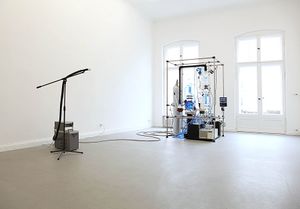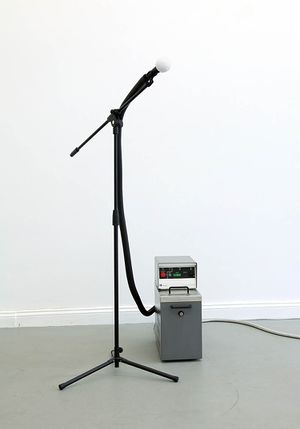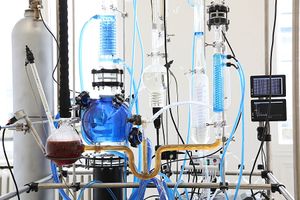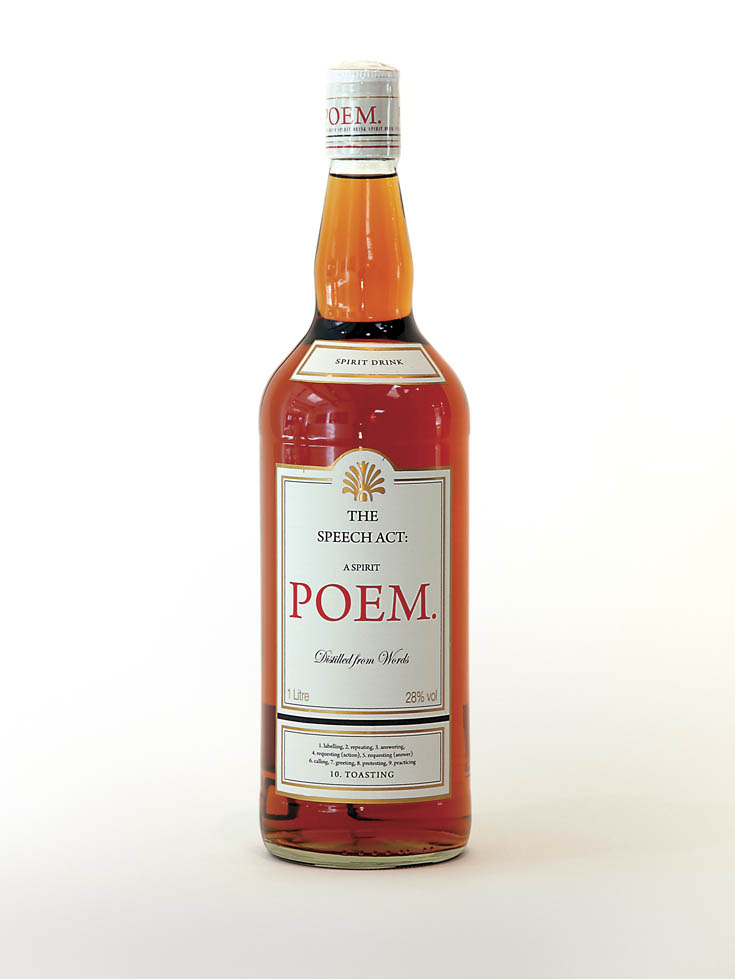POEM
Aus Daimon

Talk − distil − drink. So the repetitive formula goes. The more people talk about art, the more art is being produced in the shape of ice, water and alcohol. And the more people drink, the more talkative they become. When we talk, moist air escapes our mouths. The words condense against the cold metal of a horse sculpture and freeze into ice crystals. The ice layer grows thicker with each sentence to a point at which dew drops collect inside a pipe and set in motion a machine. Processes of chemical synthesis take their course, heating the liquid until it turns into steam, then pressing it through earths, enriching it with gases, and ionising it electrically. GROSSE DONDON, or “fat mother,” one part of the machine is called, in which, under circumstances similar to a so-called Black Smoker at the bottom of the deep sea, alcohol is produced without fermentation. Simultaneously, in a different part of the machine, the water is being boiled down to a primordial soup. Circulating endlessly in the cycle of the apparatuses, the liquid transforms into organic chemistry and starts amassing amino acids. LE PÈRE RÉPÉTITIVE, or “masturbating father,” mixes his vital juices in with the fat mother’s alcohol to form a distillate that then trickles into bottles.

The bottles’ labels entangle us in stories and tell us of elixirs and essences inhabited by genies. As enzymes and catalysts they wait to become active inside us, so as to let us imagine thoughts and images, set in motion actions and neuronal programmes, and alter realities. While the word stood at the beginning, at the end of the process we find the genie in the bottle that, swig for swig, triggers new speech acts in order again to feed the machine of art. For Thomas Feuerstein, the linguistic constitution of art becomes the starting point of an art that materially binds distillates from language and blends them with biochemical and social processes of life. With Feuerstein, language reaches well beyond communication and data storage, aims for a hypostatic transformation that turns the breath of the words into molecular sculptures. The talking about art is turned into the material of art, which, as a spirituous liquor, is returned to the physical metabolism of the body talking.

SOME VELVET MOURNING, the machine collecting the horses’ tears in the sculpture WHERE DEATHLESS HORSES WEEP, not least is an ironical and pataphysical machine that brings forth molecules as if they were spirits and demons. Art, nature, science, and quotidian life are condensed here into the spirit of life. On that note: Kippis!
Weblinks
POEM., hgg. v. Herbert Fuchs und Klaus Thoman, SCHLEBRÜGGE.EDITOR, Wien 2011
Astrid Mania, Schöpferisch Besaufen
Gerald Nestler, Wenn sich Dämonen, Destillate, Algorithmen und Algen zum Symposium versammeln
Markus Neuwirth, Review, FlashArtonline.com
Romana Schuler, In der Molekularküche des Gesellschaftsgenetikers
Nicolas Balacheff, L’art et la question des origines
Thomas Feuerstein, POEM., 2009. Ethanol, Aminosäuren, Glas, C-print auf Folie, 21 x 8 x 8 cm. Courtesy Galerie 401contemporary, Berlin
